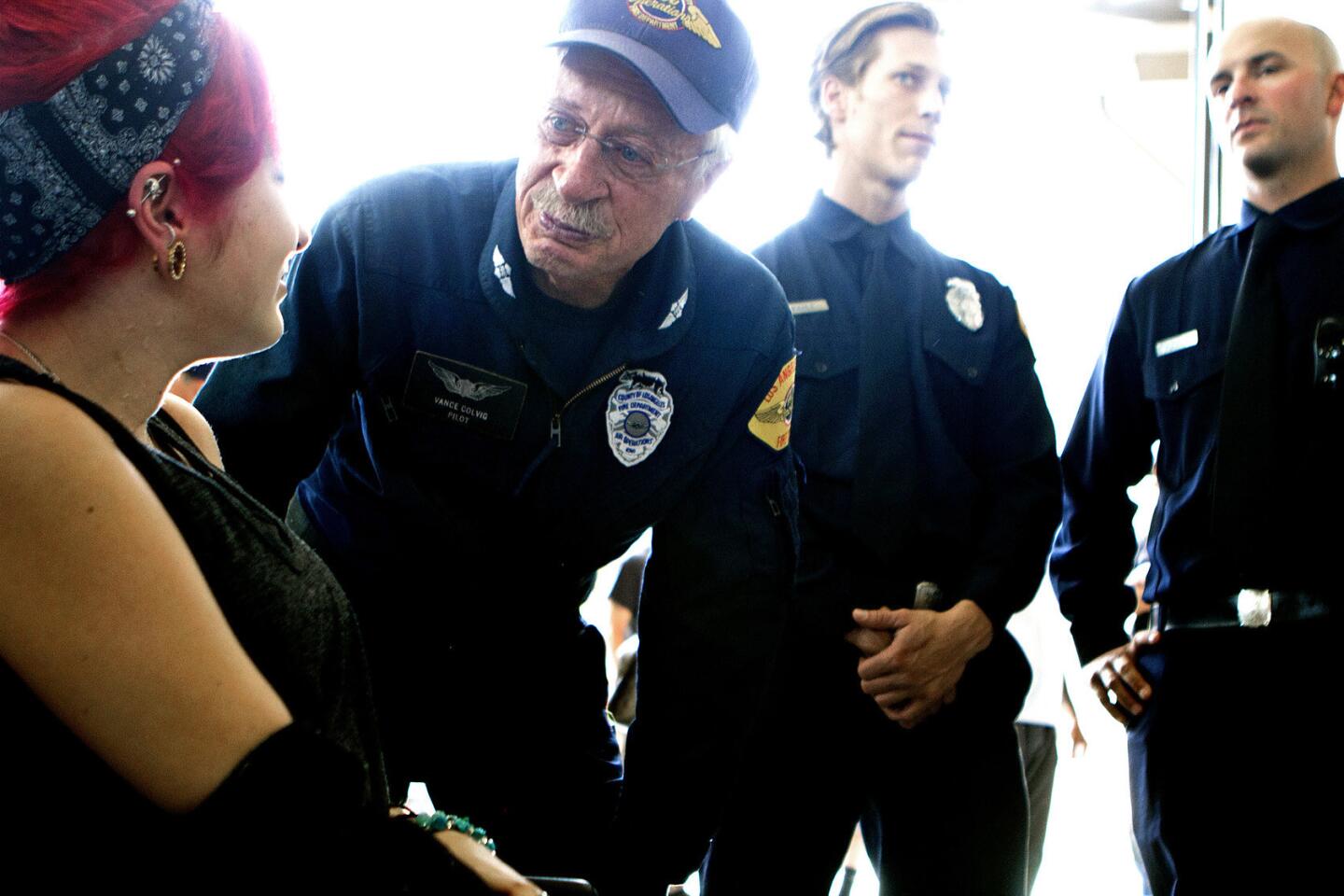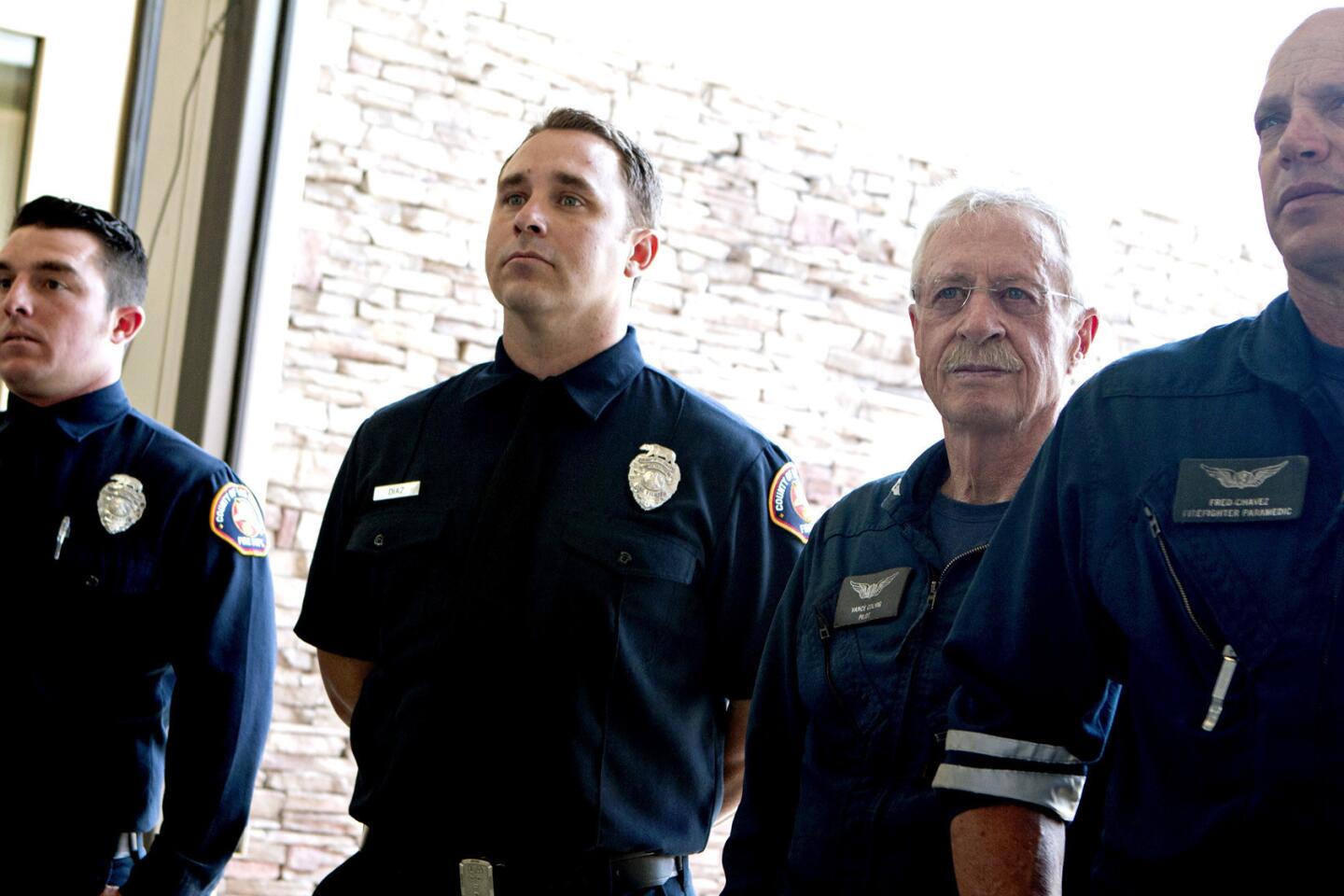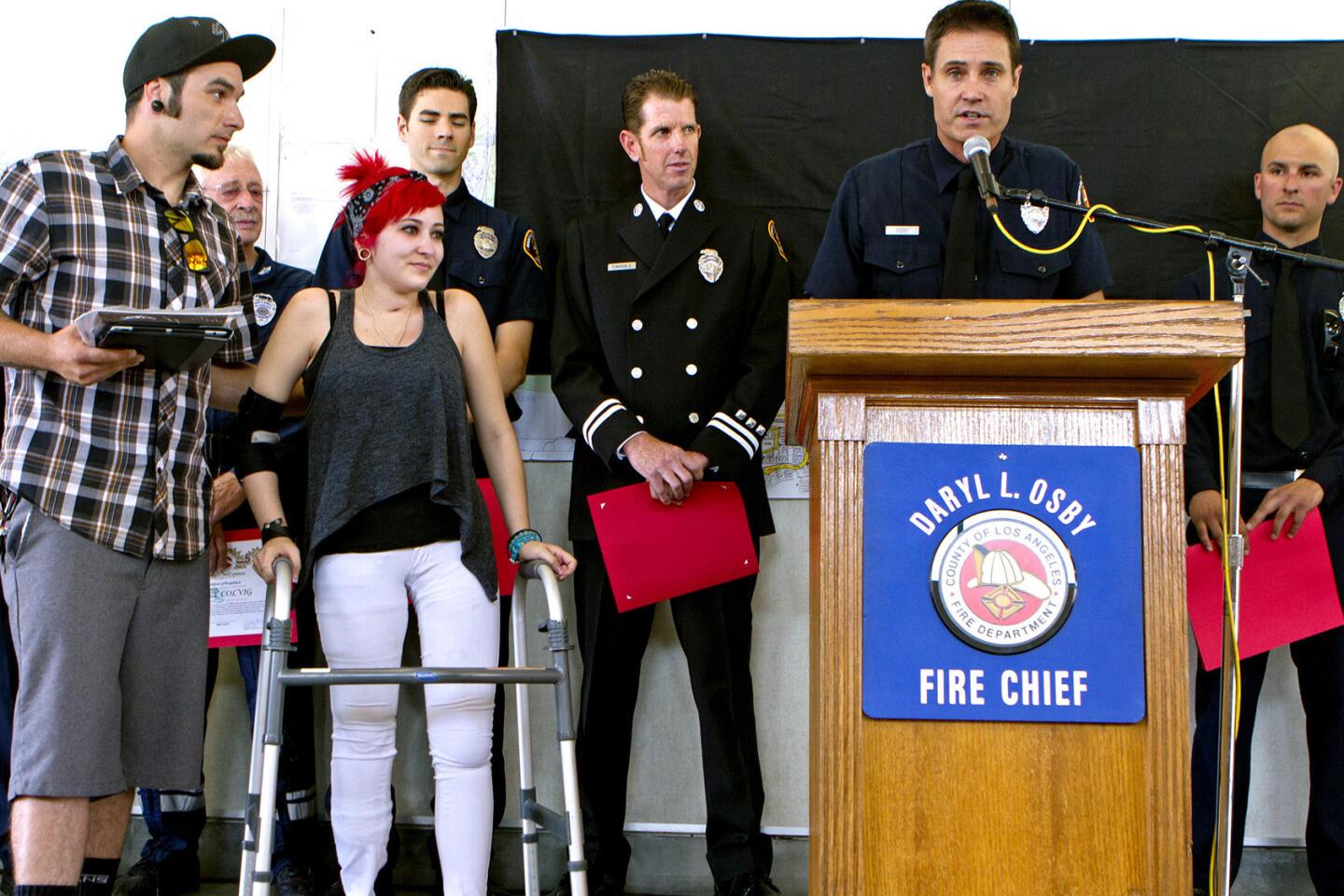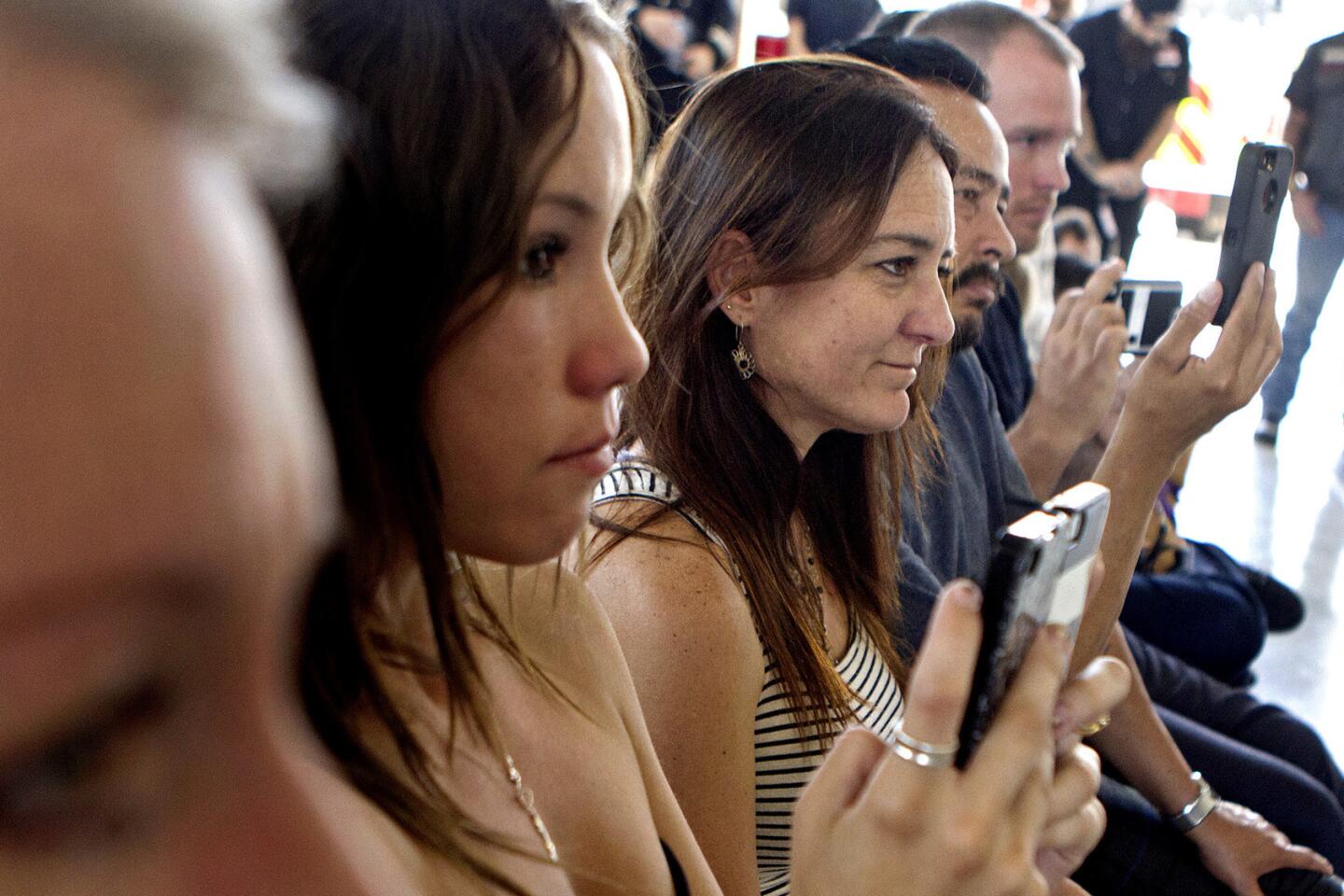Great Read: Accident survivor and rescuers meet their heroes in each other
Capt. Jeff Swingle sat alone in a workshop in his garage, his mind wandering in circles.
His day job was fighting brush fires and leading emergency response teams. He had grown accustomed to tragedy, to packing up his emotions in preparation for the next call.
But this one didn’t feel real — a snowboarding accident in Northern California, his son Wyatt dead.
Sometimes the grief overwhelmed him, and he would retreat to his workshop with no projects in mind, just remembering Wyatt and trying to accept that he was gone. Today he fought the heaviness in his chest for an hour.
Then the phone rang.
“Remember the girl in Topanga Canyon?” the voice on the line said. “She’s alive.”
::
On a Sunday afternoon in February 2013, a motorcyclist in Topanga Canyon lost control of his bike and slid into oncoming traffic. His passenger, Courtney Jones, then 23, was trapped underneath a car and dragged for 20 feet.
As Engine 70 from the Los Angeles County Fire Department hurtled toward the scene, Swingle told his crew what he always does: Be safe, work quickly, stick to procedure.
They found Jones motionless on her stomach in the middle of the road with her head turned. Medic Jesse Diaz hurried to her side. He could see her face through the visor of her helmet. She was deathly pale.
Diaz and another medic assessed her injuries and started an IV. They placed her on a backboard, loaded her into a vehicle and sped to a waiting helicopter three miles down the road. Then the helicopter took off.
Most of the time, Swingle said, that’s when the story ends. Privacy laws forbid the firefighters from following up with victims, and victims rarely know the names of their rescuers.
That Saturday they did what they always do. The paramedics packed up their gear, drove back to the station and waited for the next call. Someone made lunch. The older guys told the younger guys to put it out of their heads. Topanga Canyon’s serpentine two-lane roads are popular with motorcyclists and bicyclists, and each shift is filled with repetitive and anonymous tragedy.
But some people lodge in their memories.
Diaz thought of Jones as he drove home every day past the accident site. She reminded Vance Colvin, the helicopter pilot, of his daughter, an adventurous 18-year-old also named Courtney. Swingle, who had just been promoted to captain, thought of his own daughter, who had recently begun to date a guy who liked to ride motorcycles.
“I guess nothing was different about it,” Swingle said. “She was just very young,”
Most of the others assumed she had died. For the next year, they would remember the young woman who had fought so hard to live that she tore out her IV, ripped her helmet off and slapped a medic in the face.
Everyone wondered: What happened to Courtney Jones?
::
Doctors gave her just a 4% chance of survival. Her family and her boyfriend, who was driving the motorcycle, were told multiple times to prepare for the worst.
The accident had shattered her left leg and pelvis and left her with four broken ribs, a broken right shoulder, a broken collarbone, a fractured spine and a fractured skull. The 20-foot slide had scraped flesh from bone in four places. All of her organs were failing. Surgeons had to cut her abdomen open so often for operations that it wouldn’t close without a skin graft.
As she dropped in and out of consciousness over the next few months, infection and gangrene spread up her legs. Doctors were forced to amputate her left leg up to the hip, and she lost her right leg below the knee.
Four months and 13 surgeries later, Jones awoke in a bed in the intensive care unit at Ronald Reagan UCLA Medical Center and tried to remember why she was there. There was an intense pain in her left leg and an itch in her right foot. She begged the doctors to make the pain stop and asked a nurse to scratch the itch. The medical team could only stare. Then a nurse broke the news.
“I was me one day,” Jones said. “Then the next day I wasn’t.”
Each day, her family and boyfriend tried to motivate her with a goal. Focus on your liver, her family would tell her one day. Focus on your breathing, they’d say another day. Some days were too bleak, and on those days, they sat in silence and held her hand.
When she finally came home after five months in the hospital, she weighed 64 pounds and had lost much of her muscle.
“Everyone tells me this is the easy part, but I don’t remember fighting for my life. For me this is the hard part,” Jones said.
She was strong enough to survive the accident and the surgeries. She was brave enough to meet the pain with a smile. She had supportive friends and a loving family who raised enough money through a donation website to help pay the bills and buy prosthetic legs.
But what remains is a future filled with struggle, and that is still difficult to accept, Jones said.
There’s constant pain that medication can’t dull. There’s several hours of grueling physical therapy every week. She still needs surgery to fix her stomach. She used to dance competitively, teach gymnastics and model for motorcycle shops. Now sitting up exhausts her. She never cried so much before.
She tries to fill her life with reasons to be grateful — quiet moments with her boyfriend; reaching for support on Instagram, where she has nearly 2,000 followers; a new Chihuahua puppy named Chevy; and plans to rebuild a ’69 Camaro with her dad.
When she feels particularly thankful to be alive, she thinks of the accident and the men who pulled her out of the wreckage.
“I wish I knew who they were,” Jones said last September. “I just want to thank them.”
::
As Jones rolled up to Fire Station 89 in Agoura Hills in her wheelchair, she started to cry.
On her right, the helicopter that had flown her to the trauma center more than a year earlier was landing in a grassy field. Diaz, Colvin, Swingle and the rest of the men involved in her rescue were waiting inside the station.
After a reporter who wrote about Jones’ accident called the Los Angeles County Fire Department to put Jones in touch with her rescuers, officials set up a commendation ceremony that took place Saturday.
Swingle smiled and greeted Jones when she got inside. He was struck again by how young she was. And, this time, how beautiful.
A few weeks before, she had dyed her hair red for the fire department, and on this day she wore it in a bun near the top of her head, a few strands escaping like a pompom. Half of her head had been shaved for surgery, but the look could have been punk rock. A stuffed dolphin backpack hung off the back of her wheelchair. White leggings covered her new legs.
She wheeled over to a space in the front row, nerves buzzing; she’d never walked in public before — only in therapy. But she wanted to try.
A crowd of friends and family trickled in, and when the ceremony began, Swingle took the podium.
He thanked Jones for coming, and when he talked about her, it wasn’t clear who had rescued whom.
“She pulled me out of a bad spot,” Swingle said. She was an example of strength and resilience at a time when his family was searching for it, he said.
After the ceremony, he planned an addition to the wall of memories in his garage: The Fire Department commendation for Jones’ rescue, framed with a picture of her underneath the glass.
Then it was Jones’ turn to speak. She looked up at the men who had rescued her, many of whom were tearing up, and suddenly found she wasn’t nervous anymore. She placed her hands on the armrests of her wheelchair, and pushed herself up, elbows trembling with effort.
Then she gripped her walker, straightened her back and took a step, the first of many.
More to Read
Start your day right
Sign up for Essential California for news, features and recommendations from the L.A. Times and beyond in your inbox six days a week.
You may occasionally receive promotional content from the Los Angeles Times.













